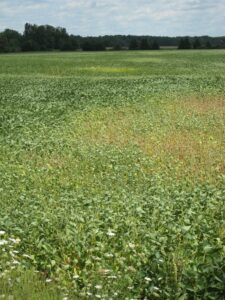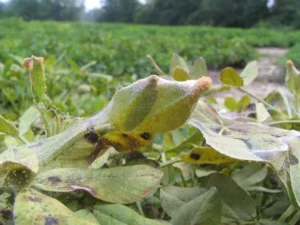Over the past few days, I’ve received several calls from growers and consultants at a crossroads about continuing to spend money on insect control in cotton. Much of the cotton in West Tennessee is not irrigated and the unseasonable dry growing conditions experienced since May have forced several fields into early cutout and halted growth. With rain chances as of 7/15/2022 continuing to be few and far between, what considerations should be made when spending money on insect control in severely drought stressed cotton?
Tarnished plant bugs are an insect that must be kept under control no matter the growing conditions. Stunted, poorly growing cotton is not as attractive to plant bugs as lush, rank cotton and numbers will often be lower in drought stressed cotton. Management styles at this point can go a couple of different ways: decrease your thresholds, increase your thresholds or keep the same established thresholds. UT’s established plant bug threshold is 3 bugs per drop or 15+ per 100 sweeps. In severely drought stressed cotton, those thresholds can be lowered to 2 plant bugs per drop or 10 per 100 sweeps. This approach assumes that the plant will be slow to set anymore fruit and what is on the plant needs to aggressively protected. If we don’t receive any substantial rain, or you believe we won’t have time to set more fruit, this is an option that may best suit your farm.
Increasing your thresholds to 5 bugs per drop or roughly 20+ per 100 sweeps is another option. This approach should decrease the amount of applications thus decreasing the amount spent on insect control. This option may sacrifice some positions on the plant; however, money saved on the front end or bottom crop could be used to protect fruiting structures on the back end or top crop. This approach may also benefit growers if a cloudy, rain-soaked period sets in and cotton plants begin to shed squares that money was invested in to protect from plant bugs.
Keeping established thresholds essentially operates as status quo and may work best for irrigated or dry land cotton that is growing well and doesn’t require an adjustment for plant bug control.
In these situations, the use of tier 1 products such as Transform may not be warranted when Orthene can be utilized at a lower price point without sacrificing efficacy. Keep in mind that drought stressed cotton will be shorter and insecticide coverage will be better, which will help increase efficacy. Beware, Orthene does carry a risk of flaring spider mites in hot, dry weather. Diamond is another option that will provide extended residual control of immature plant bugs that will easily pay for itself as plant bug numbers increase after bloom.
Spider mite control is a much more manageable when populations are caught early. Producers have several options at their disposal but it’s hard to beat a solid application of abamectin for the efficacy and affordability. We run into issues when repeated applications of low rates, < 6.0 fl oz/a of 0.15 EC or < 1.0 fl oz/a of 0.7 SC) create resistant populations. Abamectin has failed in the Midsouth, in previous years, and almost every failure was caused by repeated applications of low rates. Abamectin rates of 10.0 fl oz/a or 2.0 fl oz/a cost roughly $6 per acre and should provide excellent control of spider mites. Another option is etoxazole (Zeal, Intervene etc.). While not as cheap as abamectin, etoxazole is a mite growth regulator that will provide extended residual control the surpasses abamectin. If mites are a recurring issue, I would highly recommend this option, appropriate rates of etoxazole run roughly $8 per acre.
So far, our bollworm moth trap numbers continue to be in the single digits across all of our trap locations in West TN but we are still a little ways out on peak moth flights. UT’s threshold for dual gene cottons (Bollgard 2) is 20% of plants have eggs present. This threshold, under drought stressed conditions, won’t change. Bollworm resistance to Cry proteins is present and increasing across much of the Midsouth and the egg threshold doesn’t give dual gene cottons an opportunity to fail. Triple gene cottons (Bollgard 3, Widestrike 3, Twinlink Plus) have a much more robust insect package that is centered on the Vip3a toxin that does most, if not all, of the heavy lifting in controlling bollworms. The threshold for 3 gene cotton is 4 or more larvae are present per 100 plants or 6% or more fruit injury is occurring. So far, the 3 gene cottons are holding up well in West TN; however, I have experienced break through infestations in triple gene cottons under severe drought stress. Bt expression is often negatively affected by environmental stressors and heavy worm infestations coupled with poorly expressing Bt cotton can equal unexpected damage. The takeaway here is scout your fields closely whether dual gene or triple gene. We still don’t need to spray on egg lay in triple gene cottons but if worms are surviving past a day or so in severely stressed 3 gene cotton, make an application. Diamides (Vantacor, Besiege, Elevest) are still the best options for worm control. Orthene plus a pyrethroid is an option but residual efficacy is limited to 5-7 days and the potential for worms to rebound is a real risk.
Insect number, crop condition and yield potential should dictate what insect control decisions are made for this crop. Growers and consultants should be realistic in terms of what is an acceptable expense on a cotton crop that may only yield a bale if weather conditions don’t improve. If we don’t receive any more rainfall in the coming weeks, the positions on the plant now may be the only lint that makes it into the basket. Finally, once your insecticide budget is exhausted, you may have to walk away.




 Large rainfall events and cool weather in late May strained Tennessee’s cotton crop. In some areas, individuals are considering replanting cotton that failed to emerge or cotton that appears to be just sitting. In other areas, reports of damaged or desiccated cotyledons have been reported and healthy, large cotyledons are hard to find most anywhere. In this blog, I cover a few rules of thumb to consider when determining whether or not to keep the stand and give a few words of advice to those that are considering May 30-something cotton.
Large rainfall events and cool weather in late May strained Tennessee’s cotton crop. In some areas, individuals are considering replanting cotton that failed to emerge or cotton that appears to be just sitting. In other areas, reports of damaged or desiccated cotyledons have been reported and healthy, large cotyledons are hard to find most anywhere. In this blog, I cover a few rules of thumb to consider when determining whether or not to keep the stand and give a few words of advice to those that are considering May 30-something cotton.